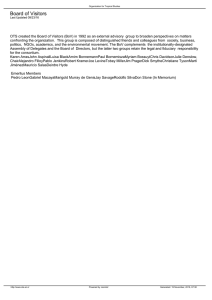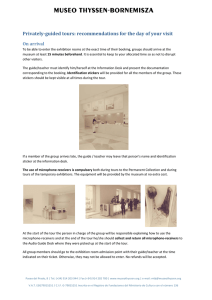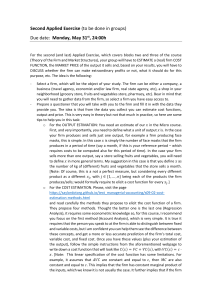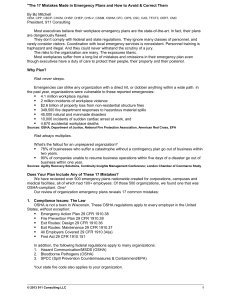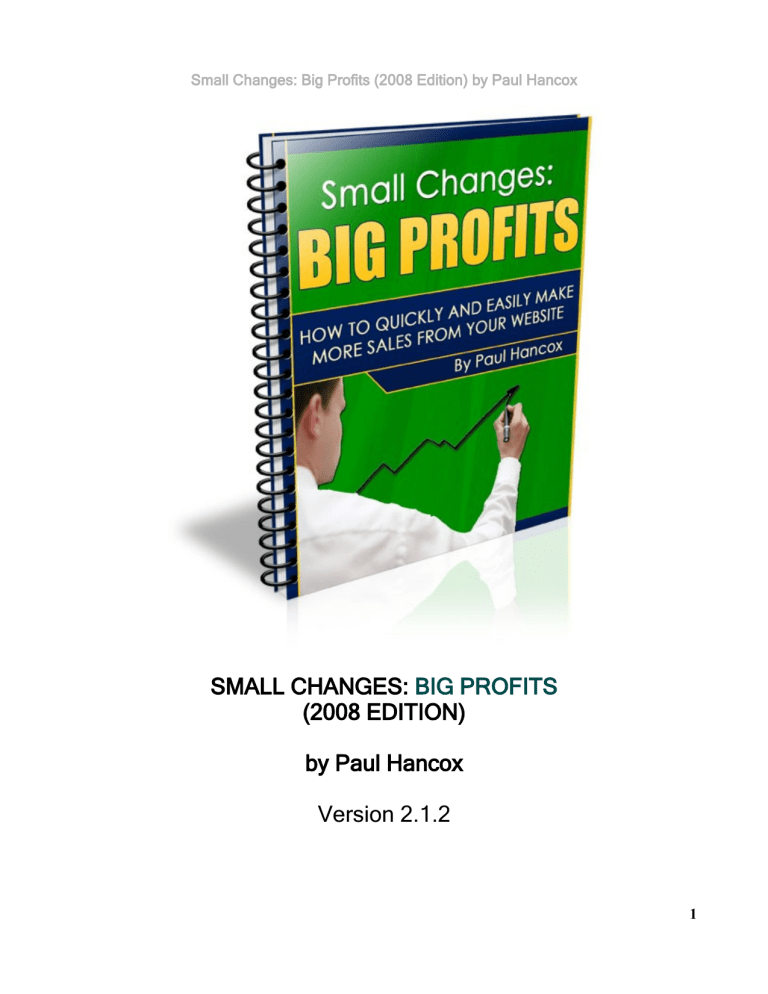
Small Changes: Big Profits (2008 Edition) by Paul Hancox SMALL CHANGES: BIG PROFITS (2008 EDITION) by Paul Hancox Version 2.1.2 1 Small Changes: Big Profits (2008 Edition) by Paul Hancox IMPORTANT NOTICE This publication does not automatically come with Resale Rights. You do not have the right to reproduce, redistribute or resell this publication in any form, without a valid Resale Rights license from the author. This publication is copyright © 2003, 2007 Paul Hancox. All rights reserved. Whilst the author and publisher has made every reasonable effort to ensure this publication is free from error, neither author, publisher, nor their affiliates and resellers assume any responsibility for errors, omissions or contrary interpretation of the subject matter herein. This publication is an information product, and is not intended for use as a source of legal, accounting or tax advice. The reader assumes all responsibility for the use of the materials and information herein, including adherence to all applicable laws and regulations. No guarantees of income, sales or results are claimed, and figures are given for example purposes only. Any perceived slights of persons, peoples or organizations is unintentional. The author and publisher (along with their resellers and affiliates) assume no responsibility or liability whatsoever on behalf of any purchaser or reader of these materials. 2 Small Changes: Big Profits (2008 Edition) by Paul Hancox CONTENTS Chapter 1 – The Key To Maximum Profits 1.1 A quick example of a 1,000% increase in profit 1.2 What four top marketers have to say about what you're about to discover 1.3 Why you, and 95% of people like you, still don't test - and why all of your excuses (whatever they are) are dead wrong 1.4 Whose opinion matters most? 1.5 Why conversion is critical for your online survival, let alone success! 1.6 How to shoot for the stars Chapter 2 – Split Testing 2.1 What is split testing? 2.2 What you need to conduct a split test 2.3 What's a conversion rate, and when should you calculate one? 2.4 Unique visitors only – if you're not unique, you're not counted 2.5 Your results – how significant are they? 2.6 Sample size – why it matters 2.7 What sample do you measure? 2.8 “Not significant” doesn't mean “No improvement” - watch the trend! 2.9 When does an X% improvement become significant? 2.10 How confident are you, anyway? 2.11 The “time” factor – beaten by a tortoise 2.12 How to conduct a basic A/B test 2.13 Don't panic! It's much simpler than you think... 2.14 What your results don't tell you 2.15 Testing the whole alphabet! 2.16 Testing on a proportion of your visitors 2.17 Split testing tools 2.18 The advantages of split testing 2.19 The drawbacks of split testing Chapter 3 – Multivariate and Taguchi Testing 3.1 What is multivariate testing? 3.2 Mix n' match testing 3 Small Changes: Big Profits (2008 Edition) by Paul Hancox 3.3 3.4 3.5 3.6 How to pick a winner The advantages of multivariate testing The drawbacks of multivariate testing Taguchi testing Chapter 4 – What To Test 4.1 What to test - Your headline – the hook that baits the fish - The “clash zone” - no loitering! - The crazy laws of pricing - The order form - Bullet points - Length of copy - Your guarantee, “Or we'll bulldoze your home!” - Testimonials - Deadlines, for the next 24 hours only! - Scarcity – only 5,000 available! - Pictures and graphics - Navigation links – and a health warning! - Payment options - Bonuses 4.2 Where do you start? 4.3 What does it mean when a test lowers your sales? 4.4 Beware of the marketing “fortune tellers” Chapter 5 – Low Traffic Testing Secrets 5.1 A testing and tracking “secret” revealed 5.2 Maximizing each conversion rate 5.3 Why testing is so important if you have low traffic 5.4 Start testing now – traffic is only the second most important factor! 5.5 The 3 Step Success Formula 5.6 How to increase your visitor to subscriber rate Chapter 6 – Email Testing 6.1 Things you can measure (and one you can't) 6.2 What to test in your emails 4 Small Changes: Big Profits (2008 Edition) by Paul Hancox 6.3 How to track subscribers to sales Chapter 7 - Advertising, Publicity and Promotion 7.1 Return on investment (ROI) and visitor value (VV) 7.2 Maximizing your ad investments Chapter 8 - How To “Spy” On Your Visitor's Every Move! 8.1 8.2 8.3 8.4 Watching your visitor's mouse movements Heat maps and mouse clicks Heat maps and eye movements Interpreting the information Chapter 9 - Eat The Breakfast Of Champions! 9.1 Feedback – when should you ask for it? 9.2 Asking the “magical questions” 9.3 An awesome psychological secret (or, How to increase your chance of getting a hot date, even if you’re not their “type”!) 9.4 The power of “because” 9.5 How to get feedback from visitors who absolutely won’t give you their email address! 9.6 Gathering feedback from your customers 9.7 Setting up automatic customer feedback loops 9.8 Using feedback to improve your testing success Chapter 10 - Pushing The Limits 10.1 10.2 10.3 10.4 Segmenting your campaigns Improve your ad targetting Pre-qualifying your visitors Pre-selling, or How to get your affiliates selling like crazy! Chapter 11 - Thinking “Out Of The Box” 11.1 “Unusual” things to test – you won't see your average “guru” mention these, but they could increase sales! 11.2 Testing on blogs 5 Small Changes: Big Profits (2008 Edition) by Paul Hancox 1 The Key To Maximum Profits 1.1 A quick example of a 1,000% increase in profit According to the August 2007 edition of Target Marketing Magazine, “...research indicates that the average conversion rate - that is the ratio of orders to overall site visits - is 2.9 percent.” Since this research didn't include smaller online marketers, I suspect that the actual average is lower – probably closer to 1% or 2%. Of course, these studies could never tell us whether 1% is good or bad, because it depends what you're selling. For instance, if you're selling a $50 million jet engine, then 1% would bring in a lot of money! You only need 100 visitors to make a $50 million sale. However, if you're selling a $50 product, and your site converts 1% of your visitors into customers, then every 100 visitors will earn you $50. How much of this is actual profit will depend on your costs. If it costs you $40 to get these visitors, then you're making a profit of just $10. So you'll need a lot of traffic to make a lot of profit! For instance, if you wanted $1,000 a month profit, you'd need at least 10,000 visitors a month (assuming that your costs per visitor remained the same). Creating that many visitors can be hard work! You could, of course, reduce your costs by finding cheaper sources of traffic – but pay-per-click advertising is generally rising in cost, and besides, cheaper ways of generating traffic often have a different cost – the cost of your time. 6 Small Changes: Big Profits (2008 Edition) by Paul Hancox However, watch what would happen if you were able to go from converting 1% to 2% of your visitors into customers. This means every 100 visitors now generates 2 new customers, which earns you $100 in revenue ($50 per customer). Your costs haven't changed – it still costs you $40 to get the same amount of visitors. Your profit is now $60. Did you notice what happened? By getting your site to convert more of your visitors into customers, your profit has gone from $10 to $60 for each 100 visitors – that's an increase in profit of 500%, without spending an extra dime! It gets better... let's see what would happen if you were to go from converting 1% to 3% of your visitors into customers. You would make 3 sales, and so $150 for every 100 visitors. Again, your costs would stay the same at $40, so your profit is now $110. In other words, your profit has gone from $10 to $110 for every 100 visitors, an awesome 1,000% increase! Now if you wanted to earn $1,000 a month profit, you'd need just 910 visitors a month – much easier to achieve than 10,000! The question is: How do we go from 1% to 3%, or from X% (your current conversion ratio) to Y% (a better one), without spending more money? The answer is to find the hidden elements in your site that are just waiting to make you profit! And I can virtually guarantee there are more than a few of these hidden elements on your site right now – you just don't know where yet. (If you did, you wouldn't be reading this report!) In this special report I'm going to show you how to find every last one of them until your site is raking in profits as easily as raking up leaves in the fall! The method we're going to use to find these hidden elements isn't a big secret – it's called testing and tracking. 7 Small Changes: Big Profits (2008 Edition) by Paul Hancox If this concept is new to you, then you're in for an exciting journey of discovery and profit! If you're already familiar with the concept, then I'm going to show you a whole bunch of things that most other marketers won't tell you about. For instance, I'll demonstrate exactly why testing and tracking is actually the single most important part of your marketing strategy (in some ways, even more important than traffic!), how to squeeze every last drop of profit from your site and hence push your conversion rate to its optimum level, exactly what to do even if your site only receives 10 visitors a day, elements you can test that most marketers have barely even considered, and how to use these techniques to generate new traffic, and even how to effectively engineer your own conversion rate! 1.2 What four top marketers have to say about what you're about to discover Here's what four of the world's top marketers have to say about the process you're about to understand more thoroughly than 95% of your competitors: Jay Abraham, internationally renowned marketing and management consultant, said this: “Simply improving the headline of an ad can multiply your results 20 times! And yet, so few people will ever test one headline against another. Or one direct-mail letter against another. Or one sales pitch against another... the leverage possibilities in each of these examples is enormous!... And it all comes from understanding the laws of testing. Testing is the key to getting the maximum leverage for your marketing money.” 1a Mark Joyner, described by many as the “Tiger Woods” of internet marketing, had this to say: “When you test, you know exactly what's working. And when you know what's working, you can duplicate that success again and again. Here is where persistence comes in. You have to be willing to try out different things and accept that most of what you try will fail. If you keep trying, sooner or later you'll hit on some winners.” 1b Terry Dean, who has sold millions of dollars of products online, asks this question: “Are you testing and tracking everything in your business? It's 8 Small Changes: Big Profits (2008 Edition) by Paul Hancox essential. Testing and tracking is the way to resolve all arguments. If you can't decide between three headlines, test all of them. The one which makes the most money for your web site is the winner. Recently I did a change in my headline... the new headline out-produced the old one by 70%.” 1c The late Corey Rudl, who was one of the earlier big names in internet marketing, said this: “I know there are a lot of you out there who do not take testing seriously. Before I increased my sales by over 300% almost overnight, I didn't test much either. However, when I saw the incredible difference a headline made, I became a testing convert.” 1d I could go on, but I think you get my point. If you're not testing and tracking, you could be missing out on a lot of extra money that could have been yours. Or, to put it another way – if you do test and track, you could turn an average campaign into a massively profitable one, just by making a few small changes, as I'll prove shortly. 1.3 Why you, and 95% of people like you, still don't test - and why all of your excuses (whatever they are) are dead wrong Whenever the subject of “testing” comes up, I hear a lot of excuse for why it's not being done. I can completely understand why people make these excuses, but I'm afraid they are hugely mistaken. Here are the top 5 excuses, and why they are wrong. Excuse #1: “I don't have the traffic right now, I'll test when I get more traffic.” Wrong! It's true that you can't necessarily get statistically valid results for certain kinds of tests if you only have 10 visitors a day – but it just means you'll need a different approach. In this report I'll show you what a low traffic site needs to do, even before you get more traffic. If you have a low traffic site, you must do this! And I'll give you an example of highly effective testing on a site with this kind of small traffic. Excuse #2: “Testing sounds like too much hard work.” Wrong. After reading this book, you'll be pleasantly surprised just how easy it is 9 Small Changes: Big Profits (2008 Edition) by Paul Hancox to test. Excuse #3: “I don't understand how or what to test.” Wrong. You're reading this book now, so shortly you'll have all the knowledge you need! Excuse #4: “Testing sounds too complicated.” Wrong. Although there are some technical things that are useful to know, you don't really need any complicated technical knowledge. As I'll show you later, most of the process is automated, so you won't need to worry about the mechanics of it. It's like a car – very complicated machinery inside, yet you drive one about quite simply using two hands and two feet. (Oh, and eyes always help.) Excuse #5: “Testing sounds too expensive.” Wrong. Although there are some expensive testing tools out there, I'll also point you to some free and low cost ones. Besides, if you're too concerned about the costs, you're missing the point. One of the key elements of business is the concept of return on investment. In other words, if you spend $50 today to generate $500 profit tomorrow, that's a great return on your initial investment. Treat any money you spend on acquiring the tools to become more profitable as an investment in your business – and, therefore, yourself! Bonus Excuse #6: “I have a dynamic site like a blog, so I don't really need to test.” Wrong. You can and should test, even if you operate a dynamic site such as a blog! Later on I'll show you how to do this. Here's the bottom line: In the end, most people don't test because they think it's easier to read someone else's story about how they increased sales by 300% just by tweaking this or that... and then to go off and adjust that on their own 10 Small Changes: Big Profits (2008 Edition) by Paul Hancox sites. The danger here is... what worked for the other site may not work for you. In fact, as I'll demonstrate in this report, it could have the opposite effect on your site! Which leads me nicely on to the question of... 1.4 Whose opinion matters most? I get emails all the time from people asking me, “For what price should I sell my product?” or “Which headline is better?” Go to any of the popular marketing forums and you'll see these types of questions being asked on a daily basis. There's no shortage of people willing to give you advice, and some of it doubtless is good advice. Also, in this report I'm going to give you examples from literally dozens of tests – and hopefully some of them will help you dramatically boost your profits. However, by the time you read this report you'll completely understand the following quote from Jay Abraham, one of the world's foremost marketing experts: “You don't have the right or the power to predetermine what the marketplace wants and what the best price, package, or approach will be. Rather, you have the obligation, opportunity, and power to put every important marketing question to a vote by the only people whose ballots count: clients and prospects, who vote with their checkbooks, credit cards, purchase orders, contracts, or raises and promotions.” 1e Let me give you a couple of real-life examples to illustrate what he means. Chuck Hildebrant and his team at Travelzoo conducted a test of background colours on their banner ads – testing light blue, yellow and red against their 11 Small Changes: Big Profits (2008 Edition) by Paul Hancox standard white background. Before launching the test, he asked his associates to come to his office and pick a colour. None of them picked red. They all had their own good marketing reasons for picking light blue or light yellow. The test was launched. All the colored banners improved results over the white one: blue by 2%, yellow by 7%, and red by... 22%. Nobody picked the one that performed best in actual tests. 1f Greg Linden at Amazon created a prototype to show personalized recommendations based on items in the shopping cart. You add an item, recommendations show up; add another item, different recommendations show up. The prototype looked promising, but a marketing senior vice-president was dead set against it, claiming it would distract people from checking out. Greg was forbidden to work on it any further. Nonetheless, Greg ran a marketing experiment, and the feature won by such a wide margin that not having it live was costing Amazon a noticeable chunk of change. With new urgency, shopping cart recommendations launched. Since then, multiple sites have copied cart recommendations. 1g The late great copywriter Gary Halbert would often ask the readers of his newsletter – a very savvy audience of marketers, copywriters and business owners – what they thought of particular advertisements he'd written. One famous example was his Rolls Royce Letter. Here's a few samples from the actual ad he wrote: ... “What you are looking at is a picture of a Rolls Royce Silver Shadow I can sell you so cheaply you will find it hard to believe! ... if you so desire, I have worked out a way to finance cars over a period of four to five years at a very favorable rate of interest. 12 Small Changes: Big Profits (2008 Edition) by Paul Hancox ...Please call me as soon as you read this letter. Right now, I only have five of these wonderful bargains and they won't last long! My number is 000-000-0000. ...P.S.S: There is another "mystery reason" why I can sell these Rolls Royces so cheaply, but I would prefer not to reveal it until we talk on the phone. Thank you. Go and read the full ad here. Gary asked his readers, “Tell me if you think the letter was a winner, a loser, or just mediocre.” In his next newsletter, he revealed some of his readers thoughts. “I have never posted a letter for the review of my readers before that was so universally trashed as this one. Most of you decided this letter sucked.” Here are a few extracts of comments from his readers that Halbert shared: "... I think it was a loser because of the continued Self-Reference... Noone cares about I. They care about [themselves], so people don't see themselves in the car, they see [me] selling it." "... I think at best it was mediocre, probably a loser. It sounded desperate to me." "... The beginning of the letter does absolutely nothing to grab my attention. You don't tell me how you got my name and exactly why you're writing me. You attempt to position yourself as a "non salesman," yet it's abundantly clear you're trying to sell me an R.R... It totally makes you sound like a sleazy used car salesman. On a scale of 13 Small Changes: Big Profits (2008 Edition) by Paul Hancox 1-10, your believability factor is about a 2." "My take on this particular ad is that it was not successful. The use of the word "cheaply" at the beginning was somewhat of a turn off in my mind... The final reason I would guess this was not successful was the emphasis on financing. Even a used Rolls would cost a pretty penny, and my belief is that the driver of this class of car would not necessarily need the financing options. The emphasis would be a possible turn off to a potential buyer for whom financing is not a problem..." "The letter did not grab me at all. When you stated you wanted to "sell me", just rubbed me the wrong way. I don't know who this person is and why should I trust him? To me, there was no excitement." As Gary said, most of his readers thought the ad sucked. So how did it do? Says Gary: “We never made a second mailing of that letter. Because... that letter sold out every Rolls Royce he had in stock in three days and every Rolls Royce he could backorder.” In fact, in his newsletter (and in the ad itself) Halbert held back on a little secret that justified selling them at a much lower price – they all had right-hand drives. According to Gary, this wasn't a problem – he'd driven one himself and it took two minutes to adjust, and none of the other buyers had problems with it. So why have I spent so many words on this example from Gary Halbert's newsletter? It's because, to me, it perfectly demonstrates the biggest stumbling block we marketers can have to making big money – our opinions and ego. It's easy to have an opinion – everybody has one – but as these and other examples you'll see demonstrate, the only opinions that really matters are the 14 Small Changes: Big Profits (2008 Edition) by Paul Hancox voice of the voters – those who vote with their credit cards, checkbooks, purchase orders etc. And that is Jay Abraham's point. Please go back and read his quote at the beginning of this section. Don't let office consensus, forum posters, or even your inner gut feeling decide what works – let your visitors and customers do that for you. Put it to their vote – which they can cast by credit card, check, purchase order, or subscription. “Almost any question can be answered, cheaply, quickly and finally, by a test campaign. And that's the way to answer them - not by arguments around a table. Go to the court of last resort - the buyers of your product.” - Claude Hopkins, Scientific Advertising, 1923 1.5 Why conversion is critical for your online survival, let alone success! In my very first post to my Internet Influence Magic blog, I explained the situation that online businesses face: The Internet is a remarkable medium. Don't you think? It allows you and me to reach out to other people virtually anywhere in the world. It enables us to publish our thoughts instantly, sell our products to a global market, or just chat about the latest Paris Hilton incident. And yet, because everyone has the ability to do that, what tends to happen is that the overall noise gets louder. In other words, today you're already competing with so many million voices (whatever the latest stats happen to be). One thing's a virtual certainly, barring an Internet-wide crash: tomorrow, there will be more voices. The day after, even 15 Small Changes: Big Profits (2008 Edition) by Paul Hancox more than the day before. With more voices, there will be more people competing for pay-per-click advertising, more people clamoring to get your attention, more people wanting to enter your particular niche. The ones who succeed will increasingly be the ones who are earning the most money from their sites – that's how they will be able to afford the higher costs of generating traffic. The rest will end up talking to themselves. That's why you need to start testing and tracking today. If you don't, I can guarantee someone in your niche will. 1.6 How to shoot for the stars Basic instincts, social life Paradoxes side by side. Don't submit to stupid rules Be yourself and not a fool. Don't accept average habits Open your heart and push the limits. - Enigma, The Screen Behind The Mirror Apparently, the average site converts at around 1 or 2%. Maybe 3%. So what? Are you content to be average? You might be happy with your present 2% conversion rate, but what if you had a magical tool that could instantly tell you what your site was actually capable of converting... and you discovered it was something like 12%? In other words, for every 100 visitors, you were happy with 2 sales, when your magical tool says you could have had 12 sales. Given this new piece of information, would you still be happy? After all, you've effectively turned down 10 sales, just because you didn't know what it would take to convert them. 16 Small Changes: Big Profits (2008 Edition) by Paul Hancox First the bad news. Such a magical tool doesn't exist. The good news is that you can approximate this magical tool by continually testing and tracking, because you have no idea what your site is capable of achieving until you test, track and optimize. Also, let me put that 2% conversion rate into a different perspective for you. It means that 98% of your visitors come to your site for whatever reason, and don't buy. 98%. You have a 98% non-conversion rate. One of the things that's always bugged me is that, since 1% or 2% is touted as the average conversion rate of a commercial site, people are often content to achieve average results, and get genuinely excited when they hit 3% or 4%. If you've gone from 1% or 2%, to 3% or 4%, that's definitely a cause for celebration, and a wonderful achievement, to be sure. But I also look at it from the other perspective – a 4% conversion means I have a 96% non-conversion rate. I have 96% of people not buying from me... And I want to know why! If I have a great product, quite frankly everybody who comes to my site should be buying it! In reality, some of the people who come to your site may not be in a position to buy, or are there for some other reason, but think about this for a moment - if you owned a restaurant, and 98% of those who entered the restaurant took a good look round, and then left, wouldn't you think something was seriously wrong? And yet, on the Internet, most people are content to let 98% (or even 99%) of their visitors leave without making a purchase. And they don't even know why they're leaving! (Later in this special report I'll show you how to easily find out precisely why 17 Small Changes: Big Profits (2008 Edition) by Paul Hancox they're not buying, so you can alter your site and hence boost your sales.) Listen, don't settle for 1% if your site is potentially capable of converting many percentage points higher. As I've already demonstrated to you, what appears to be a small increase from 1% to 2% can have a profound impact on your bottom line. Wouldn't you be horrified to discover your site was actually capable of converting 10% of your visitors into buyers? Of course you wouldn't be... you'd be delighted! So the question now is, how do you go about finding those profitable elements that will help you boost your conversion rates and therefore your bottom line? There are several techniques you can use and need to understand. In the next chapter I'm going to introduce you to a concept with which you may already be familiar. It's called split testing. If you've not heard of it, you'll be in for a pleasant surprise. If you have heard of it, I'm going to open your eyes to some secrets to split testing which may well shock you. 2 Split Testing 2.1 What is split testing? Split testing, also known as A/B testing, is a marketing term originally coined by the mail order companies, who were doing tests far longer than Internet companies. Here's how they'd usually conduct a test: before sending out a mailing, they 18 Small Changes: Big Profits (2008 Edition) by Paul Hancox might take two smaller samples of their mailing list - samples A and B. They would prepare a sales letter to send to each sample, identical except for one element. This element could be a different headline, a different call to action, or even a different price! The company would then send the relevant sales letter to both samples, and they would track the sales that result from each sample. They might do this by printing a special tracking code on each letter, which the customer is asked to quote when they order. The tracking code identifies whether the mailing is from sample A or B. Or the company simply prints two different telephone numbers as its order line – one for each batch – so it can instantly tell from which batch the order is coming. By tracking each sale, they get to find out which version of their sales letter is likely to convert best. The remainder of the mailing list would then receive the version of the sales letter that resulted in the most sales. Now, the most successful direct marketers don't just test once and then rest on their laurels. They test every element of their copy. In fact, they don't just limit themselves to testing the copy. They will test everything that can be tested – including envelope shape and design, whether to include anything other than an address on the outside of the envelope, whether to use a machine printed stamp or not, and even the whole process of ordering. Many of the wealthiest direct marketers are where they are today precisely because of this technique. They didn't just assume something would work. They tested, tracked and refined the whole selling process until they discovered precisely what worked best. Then they repeated the successful campaigns over and over again, constantly trying to improve on their best results. The great news is... split testing can also be done on the Internet. Unfortunately, it's not as easy to do as in physical mailing lists – it's far easier!... as you'll see shortly. 2.2 What you need to conduct a split test As I mentioned earlier, split testing isn’t the exclusive domain of direct 19 Small Changes: Big Profits (2008 Edition) by Paul Hancox marketing, or the Internet. It can be used in just about any part of your business, as long as you have the ability to test and track. Here are the six key elements you’ll need in order to perform a split test: (1) Two versions – the control and the variation. The control is simply the version or method that’s currently converting the best. The variation is, as the name suggests, a variation of the control. (2) The ability to split fairly between the control and the variation. If you’re testing which headline pulls better for your Internet sales letter, you’ll need some way to split your traffic stream so that a proportion of your visitors see the alternative version. (3) The ability to measure actions from each split. If you’ve split your traffic into two, every time you make a sale you’ll need to know which split your visitor saw, so that you can determine which one is more effective. (4) A sufficiently large sample of results. As you’ll see shortly, you need to gather enough data to give you meaningful results. You won’t get this from just 2 or 3 actions. (5) Patience! Split testing takes time, and can take days or even weeks - although I’ll show you techniques to vastly reduce the time it takes, later on. It’s easy to start jumping to conclusions too early, but as the experience of one successful marketer (who I’ll mention later) shows, this can cost you money. (6) The ability to interpret the results correctly. I haven’t shown you how to split test yet because, without the understanding you’re about to get from this chapter, it’s easy to misinterpret the data. For instance, if you perform a test and find that letter A outperforms B by 10%, does that mean letter A is better? The answer, as you’ll see shortly, is no - at least, 20 Small Changes: Big Profits (2008 Edition) by Paul Hancox Quick, grab the full version and continue reading! 21
